Varied difficulty levels in AP Inter 1st Year Zoology Model Papers and AP Inter 1st Year Zoology Question Paper March 2019 cater to students with diverse academic strengths and challenges.
AP Inter 1st Year Zoology Question Paper March 2019 with Solutions
Time: 3 Hours
Max. Marks: 60
Note: Read the following instructions carefully.
- Answer all the questions of Section A. Answer any six questions in Section B and answer any two questions in Section C.
- In Section A, questions from Sr. No. 1 to 10 are of Very Short Answer Type. Each question carries two marks. Every answer may be limited to 5 lines. Answer all these questions at one place in the same order.
- In Section B, questions from Sr. Nos. 11 to 18 are of Short Answer Type. Each question carries four marks. Every answer may be limited to 20 lines.
- In Section C, questions from Sr. Nos. 19 to 21 are of Long Answer Type. Each question carries eight marks. Every answer may be limited to 60 lines.
- Draw labelled diagrams wherever necessary in Sections B and C.
Section – A
10 x 2 = 20
Note: Answer All questions In 5 lines each.
Question 1.
Define the term histology. What is it otherwise called?
Answer:
Histology is the study of the microscopic structure of different tissues. It is also called as Micro anatomy.
Question 2.
Radial symmetry is an advantage to the sessile or slow-moving organisms. Justify this statement.
Answer:
Animals showing radial symmetry live in water and they can respond equally to stimuli that arrive from all directions. Thus, radial symmetry is an advantage to sessile or slow-moving animals.
Question 3.
Distinguish between a tendon and a ligament.
Answer:
Tendons are the collagen fibrous tissue of dense regular connective tissue which attaches the skeletal muscles to bones. ligaments are also the collagen fibers tissue of dense regular connective tissue which attach bones to other bones.
Question 4.
What is the hematocrit value?
Answer:
The percentage of the total volume occupied by RBCs in blood is called hematocrit value.
![]()
Question 5.
Distinguish between amphids and phasmids.
Answer:
Amphids: These are the cuticular depressions present on the lips surrounding the mouth in the nematodes such as Aphasmidia animals and serve as Chemoreceptors.
Phasmids: These are the well-developed sensory organs and they occur in some nematodes such as phasmidia animals.
Question 6.
What are pneumatic bones? How do they help birds?
Answer:
Main bones in birds are extensions of air sacs without bone marrow are called pneumatic bones. These are helpful in flying to birds.
Question 7.
List any two differences between a flagellum and a cilium.
Answer:
| Flagellum | Cillum |
| 1. Flagellum helps in locomotion only. | 1. Cilium helps in locomotion, feeding and acts as sensory structures. |
| 2. Flagellum produce undular movement. | 2. Cilium produce pendular movement. |
| 3. Flagellum is about 150 µ in length. | 3. Cilium small in size 5-10 µ in length. |
Question 8.
Why do we refer to the offspring, formed by asexual method of reproduction, a clone?
Answer:
As a result of asexual method the offsprings are not only identical to one another but also exact copies of their parent. The term ‘clone’ is used to describe such morphologically and genetically similar individuals.
Question 9.
The eggs of Ascaris are called Mammillated eggs. Justify.
Answer:
Each egg of Ascaris is surrounded by a protein coat with rippled surface. Hence the eggs of Ascaris are called “mammilated eggs’.
Question 10.
What is cyclomorphosis? Explain its importance in Daphnia.
Answer:
The cyclic seasonal morphological variations among certain organisms is called “Cyclomorphosis”. In the case of Daphnia, it is an adaptation to “stabilize the movement’ in water and can resist the water currents better” to stay in the water rich in food materials.
Section -B
6 x 4 = 24
Note: Answer any six questions in 20 lines each:
Question 11.
Explain in ‘brief Biodiversity Hot Spots.
Answer:
Biodiversity hot spots: A Biodiversity hot spot is a Biogeo graphic Region that is both a significant reservoir of biodiversity and is threatened with destruction. The concept of biodiversity originated by Norman Myers. There are about 34 biodiversity hot spots in the world. As these regions are threatened by destruction habitat loss is accelerated.
e.g.:
- Western Ghats and Srilanka;
- Indo Burma;
- Hima layas in India.
Ecologically unique and biodiversity-rich regions are legally protected as in
- Biosphere Reserves-14,
- National Parks- 90,
- Sanctuaries-448.
Biosphere Reserves: An area which is set aside, minimally disturbed for the conservation of the resources of the biosphere is Biosphere reserve’. Latest biosphere reserve (17th biosphere reserve in India) is Seshachalam Hills.
National Parks: A National Park is a natural habitat strictly reserved for protection of natural life. National Parks, across the country, offer a fascinating diversity of terrain, flora, and fauna. Some important National Parks in India are – Jim Corbett National Park (the first National Park in India located in Uttarakhand), Kaziranga National Park (Assam), Kasu Brahmananda Reddy National Park, Mahavir HarinaVanaSthali National Park (AP). Keoladeo Ghana National Park (Rajasthan), etc.
Sanctuaries: Specific endangered faunal species are well protected in wildlife sanctuaries which permits eco-tourism (as long as animal life is undisturbed). Some important Sanctuaries in India (AP) include-Koringa Sanctuary, Eturnagaram Sanctuary, Papikon Dalu Sanctuary.
![]()
Question 12.
Describe the structure of a multipolar neuron.
Answer:
Multipolar neurons have one axon and two or more dendrites. Most neurons in our body are multipolar neurons.
A neuron usually consists of a cell body with one to many dendrites and a single axon.
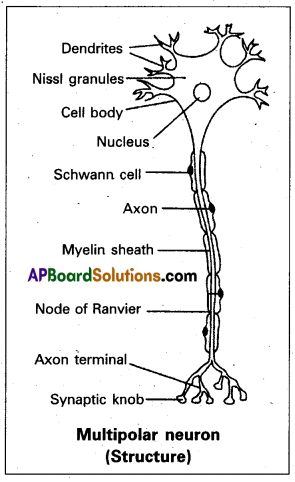
Neurons: Neurons are the functional units of nervous tissue. These are electrically excitable cells which receive, initiate, and conduct /transmit impulses. When a neuron is stimulated, an electric disturbance (action potential) is generated which swiftly travels along its plasma membrane. A neuron usually consists of a ‘cell body” with one to many dendrites and a single axon.
Cell body: It is also called perikaryon, cyton or soma. It contains abundant granular cytoplasm and a large spherical nucleus. The cytoplasm has Nissi bodies (they represent RER, the sites of protein synthesis), neurofibrils, and lipofuscin granules.
Dendrites: Several short, branched processes which arise form the cyton are called dendrites. They also contain Nissi bodies and neurofibrils. They conduct nerve impulses towards the cell body (afferent processes).
Axon: An axon is a single, long, cylindrical process that originates from a region of the cyton called axon hillock. Plasmalemma of an axon is called axolemma, and the cytoplasm is called axoplasm, which contains neurofibrils. However, Nissi bodies are absent. An axon may give rise to collateral branches. Distally it branches into many fine filaments called telo dendrites, (axon terminals), which end in bulb-like structures called synaptic knobs or terminal boutons. Synaptic knobs possess ‘synaptic vesicles’ containing chemicals called neurotransmitters.
Question 13.
What are the salient features of the echinoids?
Answer:
- It includes sea urchins, heart urchins, sand dollars, etc. The body is ovoid or discoidal and covered by movable spines.
- Arms are absent, tube feet are arranged in five bands, and bear suckers.
- Ossicles of the body unite to form a rigid test or corona or case.
- Pedicellaria are ‘three jawed’.
- Anus and Madreporte are aboral in position.
- Ambulacral grooves are closed.
- A complex five-jawed masticatory apparatus called Aristotle’s lantern is present just inside the mouth. It is absent in heart urchins.
- Life history includes larval form called echinopluteus.
- Specialized gills called peristomial gills as present in sea urchins. Eg: Salmacis (Sea urchin), Echino Cardium (Heart urchin), Clypeastoer (Cake Urchin).
Question 14.
List out eight characteristics that help distinguish a fish from the other vertebrates.
Answer:
General characters:
- Fishes are completely aquatic poikilothermic (cold-blooded) animals.
- Body of a fish is usually streamlined and differentiated into head, trunk, and tail
- The exoskeleton consists of mesodermal scales or bony plates. A few are scaleless.
- The endoskeleton may be cartilaginous or bony. Skull is monocondylic. Vertebrae are amphicoelous. Centrum is concave at both anterior and posterior faces.
- Locomotion is assisted by unpaired (median and caudal) fins along with paired (pectoral and pelvic) fins.
- Mouth is ventral or terminal. Teeth are usually acrodont, homodont, and polyphyodont.
- Exchange of respiratory gases is performed by the gills. Heart is ‘two-chambered.
- Kidneys are mesonephric. Fishes aremty ammonoltelic and some are ureotelic. (cartilaginous fishes).
- Cranial nerves are 10 pairs, Meninx Primitiva is the only meninx enveloping the central nervous system.
- Internal ear consists of three semicircular canals. The lateral-line sensory system (to detect movement and vibration in the surrounding water) is well-developed. Eyes are without eyelids and each eye ball is protected by a nictitating membrane.
- Sexes are separate. Fertilization is internal or external. Development may be direct or indirect.
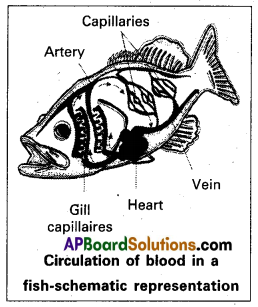
Question 15.
Give an account of pseudopodia.
Answer:
Locomotion in protozoans is performed by cellular extensions such as pseudopodia are found in rhizopods organisms. The pseudopo dia are temporary extensions of cytoplasm that develop in the direction of the movement. These temporary structures are useful to move on the substratum as our legs do, hence the name ‘pseudopodia. There are four kinds of pseudopodia in protozoans.
- Lobopodia: blunt + finger-like Pseudopodia. Ex : Amoeba, Entamoeba.
- Filopodia: fiber like pseudopodia contain ectoplasm. Ex : Euglypha
- Reticulopodia : net like pseudopodia. Ex: Elphidium.
- Axopodia or heliopodla: Sun ray-like pseudopodia. Ex : Actinophrys.

![]()
Question 16.
What are the adverse effects of tobacco?
Answer:
Effect: Smoking increases the carbon monoxide (CO) level and reduces the oxygen level in the blood. Nicotine stimulates the adrenal gland to release adrenaline and nor-adrenaline into the blood. These hormones raise the blood pressure and increase the heart rate. Smoking is associated with bronchitis, emphysema, coronary heart disease, gastric ulcers and increases the incidence of cancers of throat, lungs, urinary bladder, etc. Smoking also paves the way to hard drugs. Yet smoking is very prevalent in society, both among young and old. Tobacco chewing is associated with an increased risk of cancer of the oral cavity.
Question 17.
Draw a neat and labelled diagram of the salivary apparatus of cockroaches.
Answer:
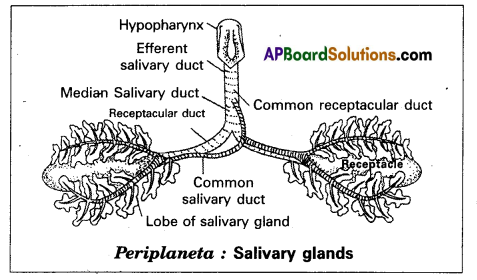
Question 18.
What are the deleterious effects of depletion of ozone in the stratosphere?
Answer:
The depletion of ozone is particularly marked over the Antarctic region. This has resulted in the formation of a large area thinned ozone layer commonly called as the ozone hole.
UV radiation with wavelengths shorter than that of UV-B, are almost completely absorbed by Earth’s atmosphere, provided that the ozone layer is intact. But UV-B damages DNA and may induce mutations. It causes ageing of skin, damage to skin cells, and various types of skin cancers. In human eye, cornea absorbs UV-B radiation and a high dose of UV-B causes inflammation of cornea called snow-blindness, cataracts, etc., such exposure may permanently damage the cornea.
Section – C
2 X 8 = 16
Note: Answer any TWO questions in 60 lines each.
Question 19.
Describe the life cycle of Plasmodium vivax in mosquito.
Answer:
Life cycle of plasmodium in mosquito (The mosquito phase) Ross cycle:
When a female Anopheles mosquito bites and sucks the blood of a malaria patient the gametocytes along with the other stages of the erythrocytic cycle reach the crop of mosquitoes. Here all the stages are digested except the gametocytes. Further part of the life cycle consists of
- Gametogony
- Fertilization
- Formation of ookinete & oocysts
- Sporogony.
i) Gametogony: The formation of male and female gametes from the gametocytes is called gametogony. it occurs in the lumen of the crop of mosquitoes.
Formation of male gametes: During this process, the nucleus of the microgametocyte divides into eight daughter nuclei called pronuclei which reach the periphery. The cytoplasm is pushed out in the form of eight flagella-like processes. into each flagellum-like process, one pronucleus enters and forms a micro gamete or male gamete. These male gametes show lashing movements like flagella and get separated from the cytoplasm of microgametocyte. This process is called exflagellation.
ii) Formation of female gamete: The female gámetocyte undergoes a few changes and transforms into a female gamete. This process is called maturation. The nucleus of the female gamete moves towards the periphery and the cytoplasm at that point forms a projection. This projected region is called the fertilization cone.
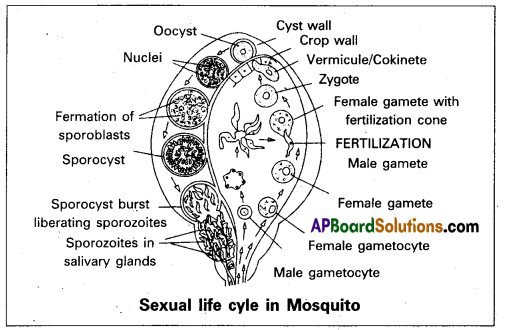
Fertilization: The fusion of male and female gametes is called fertilization. It also occurs in the lumen of the crop of the mosquito. When an actively moving male gamete comes into contact with the fertilization cone of the female gamete, it enters it, the pronuclei and cytoplasm of these two gametes fuse with each other, resulting in the formation of a synkaryon. Since the two gametes are dissimilar in size this process is known as anisogomy. The female gamete that bears the synkaryon is called the zygote which is round and non-motile.
iii) Formation of ookinete and oocysts: The zygote remains inactive for some time and then transforms into a long, slender, motile, vermiform ookinete or vermicule within 18 to 24 hours. It pierces the wall of the crop and settles beneath the basement membrane. It becomes round and secretes a cyst around its body. This encysted ookinete is now called an oocyst. About 50 to 500 oocysts are formed on the wall of the crop and appear in the form of small nodules.
iv) Sporogony: The formation of sporozoites in the oocysts is called sporogony. According to Bano, the nucleus of the oocyst first undergoes reduction division followed by repeated mitotic divisions resulting in the formation of about 1,000 daughter nuclei. Each bit of nucleus is surrounded by a little bit of the cytoplasm and transforms into a sickle-shaped sporozoite. Oocyst with such sporozoites is called sporocyst.
When this sporocyst raptures, the sporozoites are liberated into the hemocoel of the mosquito. From there, they travel into the salivary glands and are ready for infection. The life cycle of plasmodium in mosquitoes completes in about 10 to 24 days.
Question 20.
Describe the respiratory system of cockroaches with the help of neat and labelled diagrams.
Answer:
Due to the absence of respiratory pigment, the blood of cock roach is colourless and is cannot carry oxygen to different tissues. Therefore a tracheal system is developed to carry the air directly to the tissues. The respiratory system of cockroaches consists of stigmata, tracheae, and tracheoles.
Stigmata or spiracles: The tracheal system communicates with the exterior by ten pairs of openings called stigmata or spiracles. The first two pairs of spiracles are present in the thoracic segments, one pair in mesothorax and one pair in the metathorax. The remaining eight pairs abdominal segments. Spiracles are located in the pleura of their respective segments. The respiratory system in insects is classified on the basis of number and nature of spiracles.
The spiracles of cockroaches are polytheistic (as they are more than 3 pairs) and holocaustic (as all of them are functional). All spiracles are valvular and each of them is surrounded by a chitinous ring called peritreme. All spiracles bear small hair-like structures called trichomes to filter the dust particles.
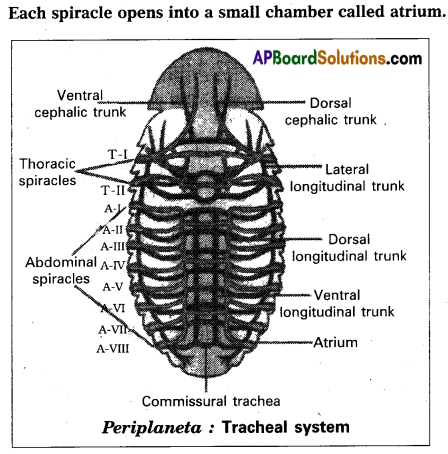
Tracheae: From the atrium of each thoracic spiracle several horizontal tracheae run inside. They join with each other in the thorax to form many tracheal trunks like dorsal cephalic, ventral cephalic trunks and their branches. These branches enter all organs of the head. The thoracic region also contains lateral longitudinal trunks.
The abdominal spiracles lead into atria. From the atrium of each abdominal spiracle three tracheal tube arise. All these tracheal tubes of one side open into three separate longitudinal tracheal trunks. They are lateral dorsal and ventral longitudinal trunks. Lateral longitudinal trunks are the longest tracheal trunks.
The three pairs of longitudinal tracheal trunks of both the sides are interconnected by many commissural tracheae. From all the tracheal trunks several branches are given out, which enter different organs. All tracheal branches entering into an organ end in a special cell called tracheoles cell.
The wall of the tracheae is made of three layers. They are an outer basement membrane, a middle one-cell thick epithelium and an inner layer of cuticle called intima. The intima is produced into spiral thickening called taenidia. The taenidia keep the tracheae always open and prevent it from collapsing.
Tracheoles: The terminal cell of trachea is called tracheoblast or tracheole cell. It has several intracellular tubular extensions called tracheoles. Tracheoles are devoid of intima and taenidia. They are formed of a protein called trachein. Tracheolar fluid is present inside the tracheoles. The level of the bachelor fluid varies with the metabolic activity of the insect.
It is more when the insect is inactive and completely reabsorbed into the tissues when the insect is more active. Tracheoles penetrate the cell and are intimately associated with mitochondria (to supply oxygen to them).
![]()
Question 21.
Describe different types of food chains that exist in an ecosystem.
Answer:
The food energy passes from one trophic level to another trophic level mostly from the lower to higher trophic levels. When the path of food energy is linear’ the components resemble the links of a chain and it is called ‘the food chain. Generally, a food chain ends with decomposers. The three major types of food chains in an ecosystem are Grazing Food Chain, Parasitic Food Chain, and Detritus Food Chain.

i) Grazing food chain: It is also known as predatory food chain, it begins with the green plants (producers), and the second, third, and fourth trophic levels are occupied by the herbivores, primary carnivores and secondary carnivores respectively. In some food chains, these is yet another trophic level – the climax carnivores. The number of trophic levels in food chains varies form 3 to 5 generally. Some examples from grazing food chain (GFC) are given below:
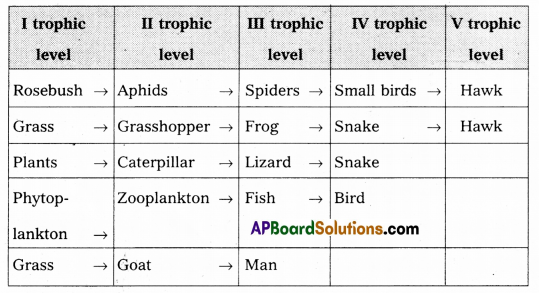
ii) Parasitic food chain: Some authors included the Parasitic Food Chains as a part of the GFC. As in the case of GFCs, it also begins with the producers the plants (directly or indirectly). However, the food energy passes from Large organisms to small organisms in the parasitic chains. For instance, a tree which occupies the 1st trophic level provides shelter and food for many birds.
These birds host many ectoparasites and endo parasites. Thus, unlike in the predator food chain, the path of the flow of energy includes fewer, large-sized organisms in the lower trophic levels and numerous, small-sized organisms in the successive higher trophic levels.
iii) Detritus Food Chain: The detritus food chain (DFC) begins with dead organic matter (such as leaf litter, bodies of dead organisms). It is made up of decomposers which are heterotrophic organisms mainly the ‘fungi and bacteria’. They meet their energy and nutrient requirements by degrading dead organic matter or detritus. These are also known as (sapro: to decompose).
DecomposerS: Secrete digestive enzymes that break down dead and waste materials (such as faeces) into simple absorbable sub stances. Some examples of detritus food chains are :
- Detritus (formed from leaf litter) – Earthworms – Frogs – Snakes
- Dead animals – Flies and maggots – Frogs – Snakes.
In an aquatic ecosystem, GFC is the major ‘conduit for the energy flow. As against this in a terrestrial ecosystem, a much larger fraction of energy flows through the detritus food chain than through the GFC.
Detritus food chain may be connected with the grazing food chain at some levels. Some of the organisms of DFC may form the prey of the GFC animals. For example, in the detritus food chain given above, the earthworms of the DFC may become the food of the birds of the GFC. It is to be understood that food chains are not ‘isolated’ always.